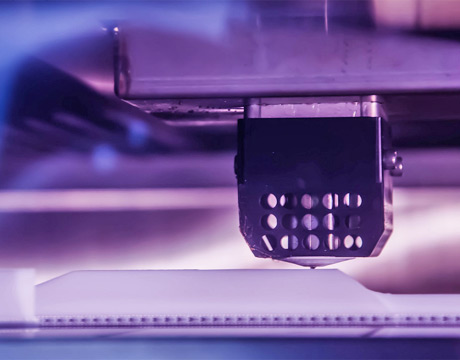Computer Simulation Optimizes Additive Manufacturing
Computer Simulation Optimizes Additive Manufacturing


Army researchers use 3D printers for rapid prototypes. Image: U.S. Army Flickr
Additive manufacturing (AM) using polymers began in the late 1980s with the introduction of stereolithography, a process that solidifies thin layers of ultraviolet (UV) light-sensitive liquid polymer using a laser. Additive manufacturing has now advanced to the point that it can form solid objects from metal powders. In the early 1990s DTM developed an AM process for the indirect manufacture of metal parts for the tooling market that used the selective laser sintering (SLS) of polymer-coated metal powders, resulting in porous parts that required post-process treatment. Similar AM-metal processes are direct metal laser sintering(DMLS) and electron beam melting.
Additive manufacturing using metals is still considered a relatively new technology, and continues to be refined. Eventually AM will allow manufacturers to make complex components, using a wide range of metal powders (including powders with nanograins), that are not possible to make with traditional casting and machining methods. This will reduce costs and improve time to market because fewer secondary steps will be required, which are time-consuming.
However, one of the biggest concerns about AM metal parts is the inconsistency of the composition and performance that often results. For example, metal powders that are nominally identical in terms of chemical analysis and grain size can result in parts with differing properties using seeming similar additive manufacturing processes. This may necessitate secondary finishing steps; inconsistent composition and structure can also impact quality, safety, and performance of the final product.
To optimize the AM process using metal, Richard Sisson, professor of mechanical engineering at Worcester Polytechnic Institute in Worcester, MA., has received a $2.66-million U.S. Army grant over two years for research entitled “Thermo-Mechanical Processing of Materials by Design.” Along with fellow mechanical engineering professors Danielle Cote and Jianyu Liang, Sisson hopes to lower the cost of manufacturing by using innovative computational modeling to improve direct-metal AM processes. Applications for this modeling include various additive manufacturing techniques, including wire arc additive manufacturing and cold spray processing.
Through-Process Computational Modeling
Sisson, Cote, and Liang plan to develop computational through-process models that can be used to predict the materials composition and mechanical properties of finished additively-consolidated materials. Other computational models will be developed that make it possible to reduce and replace rare and costly elements in materials, such as rare earth elements, that are vital to the U.S. military efforts, without sacrificing necessary performance.
Using computer software to develop alloy chemistries and heat-treating processes greatly reduces reliance upon expensive and time-consuming experiments. Computational modeling can significantly reduce the amount of time, money, and resources spent on developing a process or material because it accurately simulates that process or material performance, without actually having to do it. “The reduction in trial and error in materials and process design reduces the amount of time it takes for new materials and processes to come to not only our military, but consumers as well,” says Sisson.
Engineers will be interested in the simulation methodology and the data needed to develop the properties and performance predictions. For example, many additive manufacturing processes utilize metal powder as a feedstock material.“Our work demonstrates the importance of understanding the properties of the powder, and the resulting impact these properties have on the additively manufactured material,” says Sisson. “The significance of powder modeling and characterization is frequently underestimated, but often the properties of these powders have a direct correlation with the consolidated material.”
Ultimately, for AM parts, Sisson’s goal is to develop processes that deliver the specified properties required for the AM-fabricated part, without the post processing that is currently needed. “The through-process modeling uniquely enables us to correlate the powder specifications and key processing parameters with the properties of the manufactured parts, speeding up the advancement to achieve this goal,” Sisson adds.
Future Possibilities
Sisson successfully used the through-process modeling to optimize the cold-spray process. A through-process model will also be effective approach for AM processes, which follows the properties of the as-received powders through pre-treatments, additive manufacturing, and post-processing treatments. “Computational models are used to simulate the microstructure and properties at each stage in the through-process model,” explains Sisson. “Based on the prediction of the model, we have been able to develop powder alloys that result in parts with improved strength and desired ductility.”
Additive manufacturing will continue to have a disruptive impact on the fabrication of parts and products, across a wide range of sectors. “New developments in process modeling will allow the design of alloys and processes that provide enhanced properties and performance via the simulation with minimal experimental verification,” Sisson concludes.
Mark Crawford is an independent writer.
Based on the prediction of the model, we have been able to develop powder alloys that result in parts with improved strength and desired ductility. Prof. Richard Sisson, Worcester Polytechnic Institute





